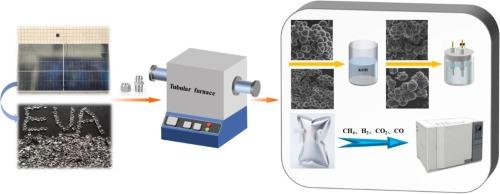利用自生压力热解法将光伏EVA树脂升级为超级电容器材料和可燃气体
IF 7.7
2区 工程技术
Q1 CHEMISTRY, APPLIED
引用次数: 0
摘要
为了应对日益增长的光伏废弃物管理挑战,开发可持续和增值处理策略势在必行。在这项研究中,利用来自废旧光伏组件和原始材料的乙烯-醋酸乙烯酯(EVA)树脂,通过自生压力热解结合KOH活化,生产分层多孔碳(HPC)和富含甲烷的可燃气体。温度相关热解实验结果表明,700℃为最佳热解条件,热解气体甲烷含量较高(43.39 vol%),热解产物为石墨化碳球。随后KOH活化生成的HPC具有765.4 m2/g的大比表面积。在6 mol/L KOH电解液中作为超级电容器电极时,在0.2 a /g下,HPC的比电容高达152 F/g。此外,具有较高醋酸乙烯含量和熔融指数(MI)的EVA树脂产生更多的甲烷和热解碳,而具有较低MI值的树脂对化学活化的反应性增强。这项工作为光伏废弃物中EVA的高价值回收提供了一条绿色高效的途径,并有助于可持续合成用于储能应用的先进高性能计算材料。本文章由计算机程序翻译,如有差异,请以英文原文为准。

Upcycling of EVA resin from photovoltaics into supercapacitor material and combustible gas by autogenic pressure pyrolysis
In response to the growing challenge of photovoltaic waste management, developing sustainable and value-added treatment strategies is imperative. In this study, ethylene-vinyl acetate (EVA) resins sourced from waste photovoltaic modules and virgin materials were utilized for the production of hierarchical porous carbon (HPC) and methane-rich combustible gas via autogenic pressure pyrolysis coupled with KOH activation. Temperature-dependent pyrolysis revealed that 700 °C was the optimal condition, yielding pyrolysis gas with a high methane content (43.39 vol%) and producing graphitized carbon spheres. Subsequent KOH activation generated HPC with a large specific surface area of 765.4 m2/g. When applied as a supercapacitor electrode in 6 mol/L KOH electrolyte, the HPC exhibited a high specific capacitance of 152 F/g at 0.2 A/g. Additionally, EVA resins with higher vinyl acetate content and melt index (MI) produced greater amounts of methane and pyrolytic carbon, while the resins with lower MI values showed enhanced reactivity toward chemical activation. This work offers a green and efficient route for the high-value recycling of EVA in PV waste and contributes to the sustainable synthesis of advanced HPC materials for energy storage applications.
求助全文
通过发布文献求助,成功后即可免费获取论文全文。
去求助
来源期刊

Fuel Processing Technology
工程技术-工程:化工
CiteScore
13.20
自引率
9.30%
发文量
398
审稿时长
26 days
期刊介绍:
Fuel Processing Technology (FPT) deals with the scientific and technological aspects of converting fossil and renewable resources to clean fuels, value-added chemicals, fuel-related advanced carbon materials and by-products. In addition to the traditional non-nuclear fossil fuels, biomass and wastes, papers on the integration of renewables such as solar and wind energy and energy storage into the fuel processing processes, as well as papers on the production and conversion of non-carbon-containing fuels such as hydrogen and ammonia, are also welcome. While chemical conversion is emphasized, papers on advanced physical conversion processes are also considered for publication in FPT. Papers on the fundamental aspects of fuel structure and properties will also be considered.
 求助内容:
求助内容: 应助结果提醒方式:
应助结果提醒方式:


